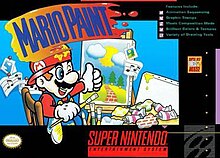
Dr. Mario is a 1990 puzzle video game developed and published by Nintendo for the Nintendo Entertainment System, Famicom, and Game Boy. It was produced by Gunpei Yokoi and designed by Takahiro Harada. The soundtrack was composed by Hirokazu Tanaka.

Super Mario World, known in Japanese marketing as Super Mario World: Super Mario Bros. 4, is a platform video game developed by Nintendo EAD and published by Nintendo for the Super Nintendo Entertainment System (SNES). It was released in Japan in 1990, North America in 1991 and Europe and Australia in 1992. The player controls Mario on his quest to save Princess Peach and Dinosaur Land from the series' antagonist Bowser and the Koopalings. The gameplay is similar to that of earlier Super Mario games; players control Mario through a series of levels in which the goal is to reach the goalpost at the end.

Wario is a character in Nintendo's Mario video game series that was designed as an arch-rival to Mario. Wario first appeared as the main antagonist and final boss in the 1992 Game Boy game Super Mario Land 2: 6 Golden Coins. His name is a portmanteau of the name Mario and the Japanese word warui, meaning "bad". Hiroji Kiyotake designed Wario and Charles Martinet voiced the character from 1993 to 2023, as well as other characters in the series, including Mario, Luigi, and Waluigi.

Super Mario Land 2: 6 Golden Coins is a 1992 platform video game developed and published by Nintendo for the Game Boy. It is the sequel to Super Mario Land. In Super Mario Land 2, the player assumes the role of the protagonist Mario, whose main objective is to reclaim his personal island, Mario Land, from the clutches of his greedy rival Wario. The gameplay builds and expands on that of its precursor with innovations carried over from Super Mario World.

Wario's Woods is a puzzle video game developed by TEC and published by Nintendo for the Nintendo Entertainment System. It was released in Japan and North America in 1994 and Europe in 1995. A spin-off of the Mario series, players control Toad in his mission to defeat Wario, who has taken control of the Peaceful Woods. Gameplay revolves around clearing each level by using bombs to destroy groups of enemies. The game also features a multiplayer mode that allows two players to compete against each other.

Wario World is a platform video game developed by Treasure and published by Nintendo for the GameCube. Part of the Wario series, it was released in Europe, North America and Australia in 2003 and Japan in 2004. The game's plot centers on Wario and his quest to regain his treasure and his castle from the evil gem, Black Jewel.
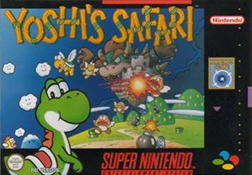
Yoshi's Safari is a 1993 light gun shooter developed and published by Nintendo for its Super Nintendo Entertainment System (SNES). It is the only Mario franchise game to feature first-person shooter gameplay and requires the SNES's Super Scope light gun. As Mario and his pet dinosaur Yoshi, the player embarks on a quest to save the kingdom of Jewelry Land from Bowser and his Koopalings, who have kidnapped its rulers and stolen 12 gems. The game features 12 levels in which the player shoots enemies like Goombas and Koopas, and collects power-ups and coins. At the end of each level, the player engages in a boss fight with an enemy, a Koopaling, or Bowser. Nintendo commissioned its R&D1 department to develop Yoshi's Safari in response to the waning popularity of the Super Scope. Yoshi's Safari was the first Super Scope title to use the SNES's Mode 7 graphics mode, and the future of the peripheral depended on the game's performance.
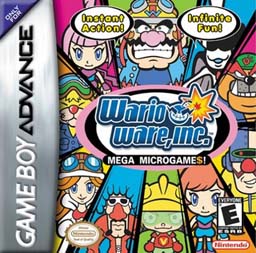
WarioWare, Inc.: Mega Microgames!, stylized as WarioWare, Inc.: Mega Microgame$! and known as WarioWare, Inc.: Minigame Mania in the PAL region, is a minigame compilation video game developed by Nintendo R&D1 and published by Nintendo for the Game Boy Advance. The debut title in the WarioWare series, the game is about rapid completion of "microgames", short minigames given to the player consecutively and with increasing speed per each game complete. The game's concept was inspired by the "Sound Bomber" mode of Mario Artist: Polygon Studio for the Nintendo 64DD. The music and sound effects were recycled from Wario Land 4. The game was produced by Takehiro Izushi and directed by Hirofumi Matsuoka. Matsuoka was also the director of Polygon Studio. Mega Microgames! was released in 2003; in Japan in March, in North America and Europe in May and in Australia in June.
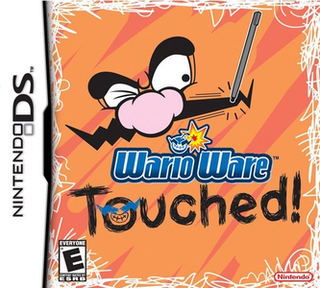
WarioWare: Touched! is a minigame compilation party video game released by Nintendo for the Nintendo DS. The fourth installment of the WarioWare series, and the first of three on the Nintendo DS, the game involves rapidly completing "microgames" — simple minigames lasting extremely short periods of time — as quickly as possible. The microgames are exclusively controlled with the Nintendo DS's touchscreen and microphone.

WarioWare: Twisted! is a video game for the Game Boy Advance, developed by Nintendo SPD with Intelligent Systems and published by Nintendo. It was released on October 14, 2004 in Japan; May 19, 2005 in Australia; and May 23, 2005 in North America. The second game in the WarioWare series and the seventh in the Wario series overall, Twisted! was the last Wario game to be released on a Game Boy family system.
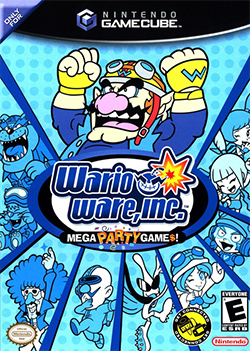
WarioWare, Inc.: Mega Party Game$! is a party video game for the GameCube. A remake of WarioWare, Inc.: Mega Microgames!, and the second installment in the WarioWare series, the game translates the "microgame" gameplay of Mega Microgames! to be playable in a multiplayer environment. It comes with eight special multiplayer modes for up to four players that all involve the known microgames in some way.

Mario Artist is an interoperable suite of three games and one Internet application for Nintendo 64: Paint Studio, Talent Studio, Polygon Studio, and Communication Kit. These flagship disks for the 64DD peripheral were developed to turn the game console into an Internet multimedia workstation. A bundle of the 64DD unit, software disks, hardware accessories, and the Randnet online service subscription package was released in Japan starting in December 1999.

WarioWare: Smooth Moves is a party video game developed by Nintendo SPD and Intelligent Systems. The game was published by Nintendo for its Wii video game system in Japan in December 2006, and in Europe, North America, and Australia in January 2007. It is the fifth game in the WarioWare series of games, and the only game in the series to be physically released for the Wii. Like its predecessors, WarioWare: Smooth Moves is built around a collection of microgames that last about five seconds each, and which require that the player hold the Wii Remote in specific positions. The game offers the microgames to the player in rapid succession, by first instructing the player to hold the Wii Remote in a specific manner, and then showing them the microgame. The microgames are divided into several stages, each of which loosely connects the microgames with the help of a story. Additionally, this was the first spin-off Mario game to be released for the console.

Wario is a video game series, a spin-off of the Mario franchise. It comprises various video games created by Nintendo, starring the character Wario. The series began with Wario Land: Super Mario Land 3, the first game to feature Wario as a playable character. The Wario series includes mostly platforming video games and minigame compilations, but also includes other genres.
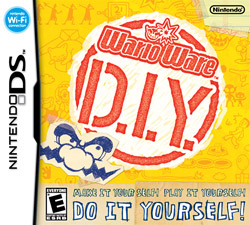
WarioWare D.I.Y., known as WarioWare: Do It Yourself in the PAL region, is a minigame compilation and game creation system by Nintendo SPD and Intelligent Systems and published by Nintendo for the Nintendo DS. It is the seventh title in the WarioWare series and the last to be developed for the Nintendo DS family of systems. Formally revealed at Nintendo's conference in October 2008, the game was released in Japan on April 29, 2009. It was released in 2010 in North America, Europe, and Australia respectively and was accompanied by a separate WiiWare title, WarioWare: D.I.Y. Showcase.

Super Mario All-Stars is a 1993 compilation of platform games for the Super Nintendo Entertainment System (SNES). It contains remakes of Nintendo's four Super Mario games released for the Nintendo Entertainment System (NES) and the Famicom Disk System: Super Mario Bros. (1985), Super Mario Bros.: The Lost Levels (1986), Super Mario Bros. 2 (1988), and Super Mario Bros. 3 (1988). As in the original games, players control the Italian plumber Mario and his brother Luigi through themed worlds, collecting power-ups, avoiding obstacles, and finding secrets. The remakes feature updated graphics—including the addition of parallax scrolling—and music, modified game physics, a save feature, and bug fixes.
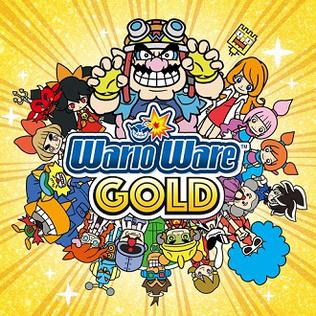
WarioWare Gold is a minigame compilation developed by Intelligent Systems and published by Nintendo for the Nintendo 3DS family of video game consoles. The ninth installment in the WarioWare series, it was released in PAL regions in July 2018, and in North America and Japan the following month. The game's plot follows the greedy Wario who has organized a gaming tournament for a large cash prize, with the ultimate goal of claiming the money for himself. Meanwhile, various other WarioWare characters deal with other problems which play out in the form of short stories.

WarioWare: Get It Together! is a party video game developed by Intelligent Systems and published by Nintendo for the Nintendo Switch. It is the tenth installment in the WarioWare series, following WarioWare Gold (2018) for the Nintendo 3DS. The game was released worldwide on September 10, 2021 and sold 1.34 million copies worldwide. It is the final game in the WarioWare series to feature Charles Martinet as the voice of Wario before his retirement from voicing the character in 2023.

WarioWare: Move It! is a party video game developed by Intelligent Systems and published by Nintendo for the Nintendo Switch. It is the eleventh installment in the WarioWare series, the second WarioWare game to be released on the Nintendo Switch, after Get It Together (2021), and the first direct sequel in the WarioWare series, being a follow-up to the 2006 Wii game, WarioWare: Smooth Moves. It was released on November 3, 2023.
